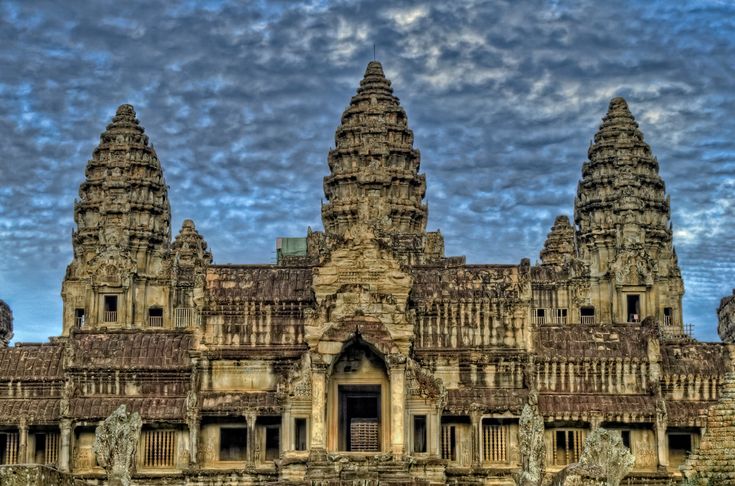Temples in Cambodia are not just architectural monuments, but living embodiments of the rich history and culture of an ancient civilization. In this article, we will look at the most famous temples in Cambodia, their historical significance, unique features and tips for tourists who plan to visit these magnificent places.
Cambodian temples are among the main tourist attractions in Southeast Asia. This region attracts travelers with its ancient architectural wonders, especially the Angkor Wat complex, the largest religious building in the world. The history of Cambodia’s temples is closely linked to the Khmer Empire, which dominated the region from the 9th to the 15th century. Traveling to these ancient places not only immerses you in the past, but also gives you a unique experience of contemplating amazing works of human and spiritual culture.
Angkor Wat: The Heart of Cambodia
History and Significance
Built in the 12th century by King Suryavarman II, Angkor Wat is a symbol of Cambodia and is depicted on its flag. The temple was originally dedicated to the Hindu god Vishnu, but over time it became a Buddhist sanctuary. Angkor Wat is an outstanding structure that demonstrates incredible achievements of ancient engineering and architecture.
Architecture
Angkor Wat is surrounded by a huge moat and powerful stone walls. Inside are five towers symbolizing the sacred Mount Meru, which is considered the center of the universe according to Hindu and Buddhist beliefs. The reliefs decorating the walls of the temple depict scenes from Hindu epics such as the Mahabharata and Ramayana, as well as historical events and mythological scenes. The most famous of these reliefs is the “Milk Ocean”, which depicts the struggle between gods and demons for immortality.
Travel Tips
The best time to visit Angkor Wat is at sunrise or sunset, when the light creates a magical atmosphere around the temple. Be sure to bring enough water and wear comfortable shoes, as the complex is huge and involves a lot of walking. Cameras or smartphones will help to capture the magic of the moment, but do not forget to also enjoy the views without technology – a live experience like no other.
Bayon Temple: The Labyrinth of Faces
Architecture
Located in the heart of the city of Angkor Thom, Bayon Temple is famous for its massive stone faces carved into the towers. This temple was built by King Jayavarman VII in the late 12th century and is dedicated to Buddhism. Its main feature is the 216 huge faces, which are believed to represent the image of the Bodhisattva Avalokiteshvara, symbolizing compassion. The faces look in all directions, creating the impression of an all-seeing gaze.
Historical Significance
Bayon symbolizes the idea of the center of the world and power, as was typical for the Khmer Empire. The stone faces, gently smiling in different directions, demonstrate a unique combination of mysticism and spirituality.
Travel Tips
The labyrinth of corridors and towers of Bayon may seem confusing, but this is its unique charm. It is recommended to take a guide who can explain the symbolism of the temple and its meaning. This temple is especially photogenic in the soft morning light, when the faces are illuminated by the first rays of the sun.
Ta Prohm: A Temple Embraced by Nature
Ta Prohm is a temple famous for its close fusion with the jungle, which, in fact, has swallowed it up over the centuries. The trees, whose roots have entwined the stone walls and grown through the buildings, create the impression of nature returning to its origins. This temple became famous thanks to the movie “Lara Croft: Tomb Raider”, where its mysterious ruins were filmed.
History
Ta Prohm was built in the late 12th century, also by order of King Jayavarman VII, and served as a monastery and university. Interestingly, the temple has been preserved almost in its original form since its discovery, leaving many trees and roots untouched to emphasize its unity with nature.
Tips for tourists
Ta Prohm is one of the most popular places in Angkor, so it is best to visit it early in the morning to avoid large crowds. Cameras are a must here, as the scenes where nature prevails over ancient architecture are incredibly impressive.
Preah Vihear: Temple on the top of the mountain
Location and history
Preah Vihear is a unique temple located on the top of the Dangrek Mountains, right on the border with Thailand. The temple was built between the 9th and 12th centuries and is dedicated to the god Shiva. It is known for its strategic position and stunning views of the surrounding area.
Architectural Features
Unlike other temples in Angkor, Preah Vihear is stretched along an axis from north to south, making its layout unusual. The ascent to the temple is via a series of steep stairs and terraces, with each level offering new and impressive views.
Travel Tips
Due to its remote location, Preah Vihear is rarely visited by tourists, but those who make the trip will be rewarded with incredible peace and beauty. It is best to rent a car or use the services of local tour operators to get to the temple.
Conclusion
Temples in Cambodia are more than just tourist attractions. They are places that allow you to look into history, feel the spirit of an ancient civilization and immerse yourself in the atmosphere of deep spiritual heritage. From the majestic Angkor Wat to the mysterious Ta Prohm, each of these places offers a unique experience and leaves a lasting impression. Whether you are traveling for culture, history or just for the amazing views, Cambodian temples promise to give you unforgettable moments.


